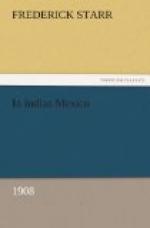Pantepec is a large town, situated near the edge of the great mountain mass, and looking across a valley, which is backed by what appears to be a flat-topped, straight-edged, table mountain. The houses of the town are scattered over a considerable area upon the slope. The walls are of poles, heavily daubed with mud which is neatly and smoothly laid on. The corners of this mud covering are rounded, instead of angular, as usual elsewhere. The thatch is heavy and firm, and squarely cut along its lower edge, where it projects far beyond the walls. The plaza is above the town-house, and is extremely ugly; a kiosk, which certainly can lay no claim to beauty, stands in the centre; ugly shacks, used as tiendas, border a part of it along the main road. Striking, at this time, in the village were the colorin trees, some of which occurred in almost every enclosure; they were in bloom, and had long, slender, flaming-red, cigarette-shaped flowers, which appeared before the leaves, from trunks that were gnarled and brown and almost branchless. Many popular danzas are celebrated here, but none was taking place during our stay. San Gregorio, the town of paper-making, is not far from Pantepec, and large quantities of the bark paper are beaten in the little village of Ixcoyotla, which belongs to this municipio. Asking an old Otomi whether he knew about this paper, he answered us, with great cunning, that we probably knew as much of it as he did. He finally condescended to state that the munecos of it were used in curing disease; that anyone who has a disease secures one of these munecos and applies it to the diseased part. The presidente insisted that this paper was not made from jonote, but from uli, and that formerly it was much used in making strong and durable belts.
[Illustration]
In starting back the next morning, we went down a different slope from the one by which we had come, with the result that we had to cross the stream five times more than before, making the full forty-four crossings, of which we had been warned by Culin while we were at Huehuetla. We made our way leisurely, stopped when we pleased, and at one point noticed a cave, which we had not seen before, just across the stream, at a point where it was at its deepest. The cave was so near the water’s edge, that it could only be approached from the stream. The boys swam across and entered it to see if perchance they might find some of the paper figures used in bruheria. They found little of interest within; the walls and rocks were marked with crosses, and on the floor were hundreds of little sticks cut to various lengths. We were glad, indeed, to reach Don Pablo’s house, to eat his good supper, and to occupy his good beds. Before we went to bed, Dona Panchita suggested that we ought to see certain munecos kept by a man named Diego, and used as idols by the village. Accordingly, she




